This article's citations lack bibliographical information.(October 2018) |
William Chandler Hines (23 March 1922 - 20 May 2016), also known as "The Leadslinger", was an American custom car builder.
This article's citations lack bibliographical information.(October 2018) |
William Chandler Hines (23 March 1922 - 20 May 2016), also known as "The Leadslinger", was an American custom car builder.
Hines was born in Erie, Pennsylvania, to Edward and Willie (Chandler) Hines. [1] He had a twin brother, Edward, and a sister Elizabeth.
Born with a severely deformed spine, the result of spinal kyphosis, he was unable to stand completely upright. At age two, he was sent to an Erie hospital, where he underwent surgery to remove two vertebrae. [2] The hospital recommended he be sent to a special camp, where he was laid on a board in the sun all day for seven months, returning over the course of two and a half years; it helped relieve the unusual curvature. [2]
Soon after Hines was initially released from hospital, his father died of tuberculosis. [1] Hines' mother moved to Detroit, Michigan to work, while her children were sent to be raised by their grandmother in Jackson, Tennessee. In 1932, the Hines children went to Detroit. [3]
In high school, Hines preferred art and shop classes to academics, and 1941, while in Grade 11, dropped out to rent a garage in Ecorse, Michigan, where he set up a custom shop. [2] It was there he began working with lead body filler. [2]
His first project was a 1934 Ford, fitted with a flathead V8 with milled heads. [4] He opened a gas station in Lincoln Park, Michigan, with an attached custom shop later the same year. [4] His first custom, built in 1941, was a 1941 Buick, with molded fenders, widened rocker panels, cut-down doors (a Hines trademark), fender skirts, Appleton spotlight, and single-bar flipper hubcaps; he repainted the original turquoise to red, claiming every custom should be red with a white interior. [2] [5] He would later add a tailfin in the center of the trunklid, a feature earning so much ridicule, he changed back to a stock lid. [4]
He went on to build and race a midget powered by a 60 hp (45 kW) flathead. [2]
In the late 1940s, Hines did bodywork and painting for Vick Sawitskas' Nash dealership in Wyandotte, Michigan. [6]
Hines finally opened his own dedicated custom shop in Lincoln Park early in the 1950s. It was there in 1957 he built Lil' Bat, a 1950 Ford with a 6 in (150 mm) chop, frenched headlights, the grille bar from a 1951 Ford Meteor, and large fins fitted with taillights from a 1956 Ford. [7] The car made its debut at the 1959 Detroit Autorama, and was featured on the cover of Rod & Custom Magazine in March 1959. [7] When he visited George Barris' shop driving this car in 1958, Barris' shop manager, Gene Simmons (not to be confused with the artist), hired him immediately on the strength of the work. [2]
Hines moved back to Detroit just before Christmas 1959,.[ citation needed ] setting up shop where he did several custom jobs and specialized in candy paint jobs. He also hired the Alexander brothers.[ citation needed ]
He served as mentor to customizers Richard Sawitskas, better known as Dick Dean, [2] and Detroit's Alexander Brothers. [8] [9] [10]
Hines returned to California in October 1960, setting up Bill Hines Kustom Auto in Lynwood, next door to Eddie Martinez's shop. [11]
In 1962, Hines installed one of the first hydraulic lift systems on Tats Gotanda's Candy blue 1959 Chevrolet Impala; this became known as the Buddah Buggy , and was Hines' most famous custom project. [2]
Hines also collaborated with Joe Bailon to produce the Panthermobile in 1969. [12] [13] [14]
Hines worked without drawing plans, able to, for instance, construct a custom working convertible top from scratch without them. [2] He also fabricated hydraulic systems. [2]
While living in Garden Grove, California, in 2015, Hines suffered a heart attack. He died five months later, at age 94.[ citation needed ]

The term 1932 Ford may refer to three models of automobile produced by Ford Motors between 1932 and 1934: the Model B, the Model 18, and the Model 40. These succeeded the Model A. The Model B had an updated four-cylinder engine and was available from 1932 to 1934. The V8 was available in the Model 18 in 1932, and in the Model 40 in 1933 & 1934. The 18 was the first Ford fitted with the flathead V-8. The company also replaced the Model AA truck with the Model BB, available with either the four- or eight-cylinder engine.
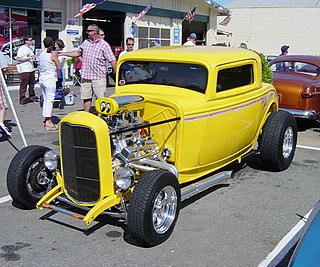
Hot rods are typically American cars that might be old, classic, or modern and that have been rebuilt or modified with large engines optimized for speed and acceleration. One definition is: "a car that's been stripped down, souped up and made to go much faster." However, there is no definition of the term that is universally accepted and the term is attached to a wide range of vehicles. Most often they are individually designed and constructed using components from many makes of old or new cars, and are most prevalent in the United States and Canada. Many are intended for exhibition rather than for racing or everyday driving.

The Lincoln Futura is a concept car promoted by Ford's Lincoln brand, designed by Ford's lead stylists Bill Schmidt and John Najjar, and hand-built by Ghia in Turin, Italy — at a cost of $250,000.

George Barris was an American designer and builder of Hollywood custom cars. Barris designed and built the Hirohata Merc. Barris's company, Barris Kustom Industries, designed and built the Munster Koach and DRAG-U-LA for The Munsters; and the 1966 Batmobile for the Batman TV series and film.
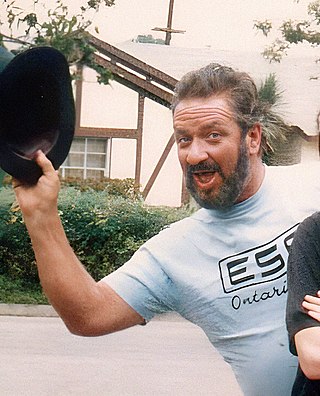
Ed "Big Daddy" Roth was an American artist, cartoonist, illustrator, pinstriper and custom car designer and builder who created the hot rod icon Rat Fink and other characters. Roth was a key figure in Southern California's Kustom Kulture and hot rod movement of the late 1950s and 1960s.

Chopping and channeling is a form of automobile customization in the "kustom kulture" and among hot rodders. The procedures are often combined, but can be performed separately. While chopping takes in only a car's pillars and windows, the more involved work of sectioning a car is carried out on the entire lower body.
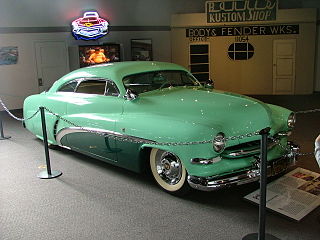
A custom car is a passenger vehicle that has been altered to improve its performance, change its aesthetics, or combine both. Some automotive enthusiasts in the United States want to push "styling and performance a step beyond the showroom floor - to truly craft an automobile of one's own." A custom car in British usage, according to Collins English Dictionary, is built to the buyer's own specifications.

The Mercury Eight is an automobile that was produced by the American manufacturer Ford Motor Company under their now defunct division Mercury between 1939 and 1951. The debut model line of the Mercury division, Ford slotted the full-size Mercury Eight between the Ford Deluxe model lines and the Lincoln. In total, Ford assembled three generations of the Eight.

The Detroit Autorama, also known as America's Greatest Hot Rod Show, is a showcase of custom cars and hot rods held each year at Huntington Place in Detroit, Michigan, in either late February or early March.
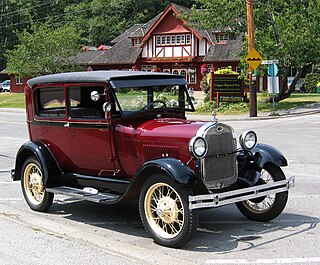
The Ford Model A is the Ford Motor Company's second market success, replacing the venerable Model T which had been produced for 18 years. It was first produced on October 20, 1927, but not introduced until December 2. This new Model A was designated a 1928 model and was available in four standard colors.
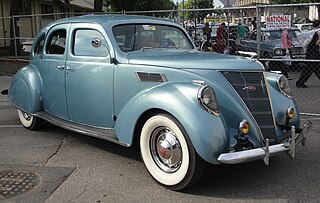
The Lincoln-Zephyr is a line of luxury cars that was produced by the Lincoln division of Ford from 1936 until 1942. Bridging the gap between the Ford V8 DeLuxe and the Lincoln Model K, it expanded Lincoln to a second model line, competing against the Chrysler Airflow, LaSalle, and the Packard One-Twenty.

The Munster Koach is the family car that was used in the television series, The Munsters. The show's producers contracted George Barris to provide the Koach. Barris paid show car designer Tom Daniel $200 to design the car, and had it built at Barris Kustoms, first by Tex Smith, but finished by Dick Dean, his shop foreman at the time. The Munster Koach appeared in over twenty episodes throughout the series' two-year run, and was also seen in Munster, Go Home! using different wheels. Tom Daniel's original drawing of the Munster Koach had it supercharged with a hood scoop and thin, round disc lights. Barris chose the ten-carburetor setup with the ten air horns and lantern lights.
Edward Dean Jeffries was an American custom car designer and fabricator, as well as stuntman and stunt coordinator for motion pictures and television programs based in Los Angeles, California.
Dick Dean, born Richard Dean Sawitskas [Sa-WITS-kas], was an American automobile designer and builder of custom cars.

The Hirohata Merc is a 1950s lead sled custom car, often called "the most famous custom of the classic era". Setting a style and an attitude, it had a "momentous effect" on custom car builders, appeared in several magazines at the time and has reappeared numerous times since, earning an honorable mention on Rod & Custom's "Twenty Best of All Time" list in 1991. The impact may be measured by the fact that, after more than fifty years and numerous owners, it is still known as "the Hirohata Merc".
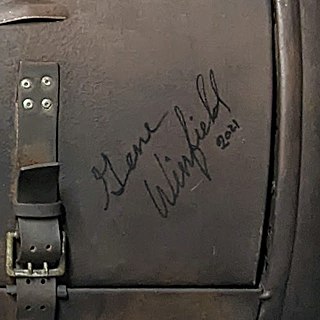
Gene Winfield is an American automotive customizer and fabricator. In the mid-1960s, his designs caught the attention of the film community, resulting in a large body of his work appearing on screen, including in the iconic 1982 film Blade Runner.
Ala Kart is a custom car, a customized 1929 Ford Model A roadster pickup, built by George Barris, Richard Peters, and Mike "Blackie" Gejeian in 1957. Originally owned by Peters, it is a two-time winner of the Grand National Roadster Show "America's Most Beautiful Roadster" (AMBR) trophy and Hot Rod cover car in October 1958. Featured in hundreds of car shows, Ala Kart has won more than 200 trophies. It has also made numerous appearances in movies, usually in the background of drive-in shots, and dozens of magazine articles since. It is considered by many to be "one of the most iconic hot rods ever built."

Polynesian is a customized 1950 Oldsmobile Holiday 88 built by Neil Emory and Clayton Jensen at Valley Custom Shop. It was built at the request of original owner Jack Stewart in 1952.
Bill Cushenbery was an American car customizer, show car builder, and model kit designer. Cushenbery was a major influence on the look of custom cars and the customizing industry in general. In addition to building his own designs, he is noted for having helped George Barris create the Batmobile car featured in the 1966–1968 Batman television series.
Sam Foose was an American automotive customizer and fabricator known for his custom metalwork as well as his paint jobs on car customizations in the 1970s and 1980s.